1993 CHEVROLET CAVALIER key
[x] Cancel search: keyPage 98 of 308
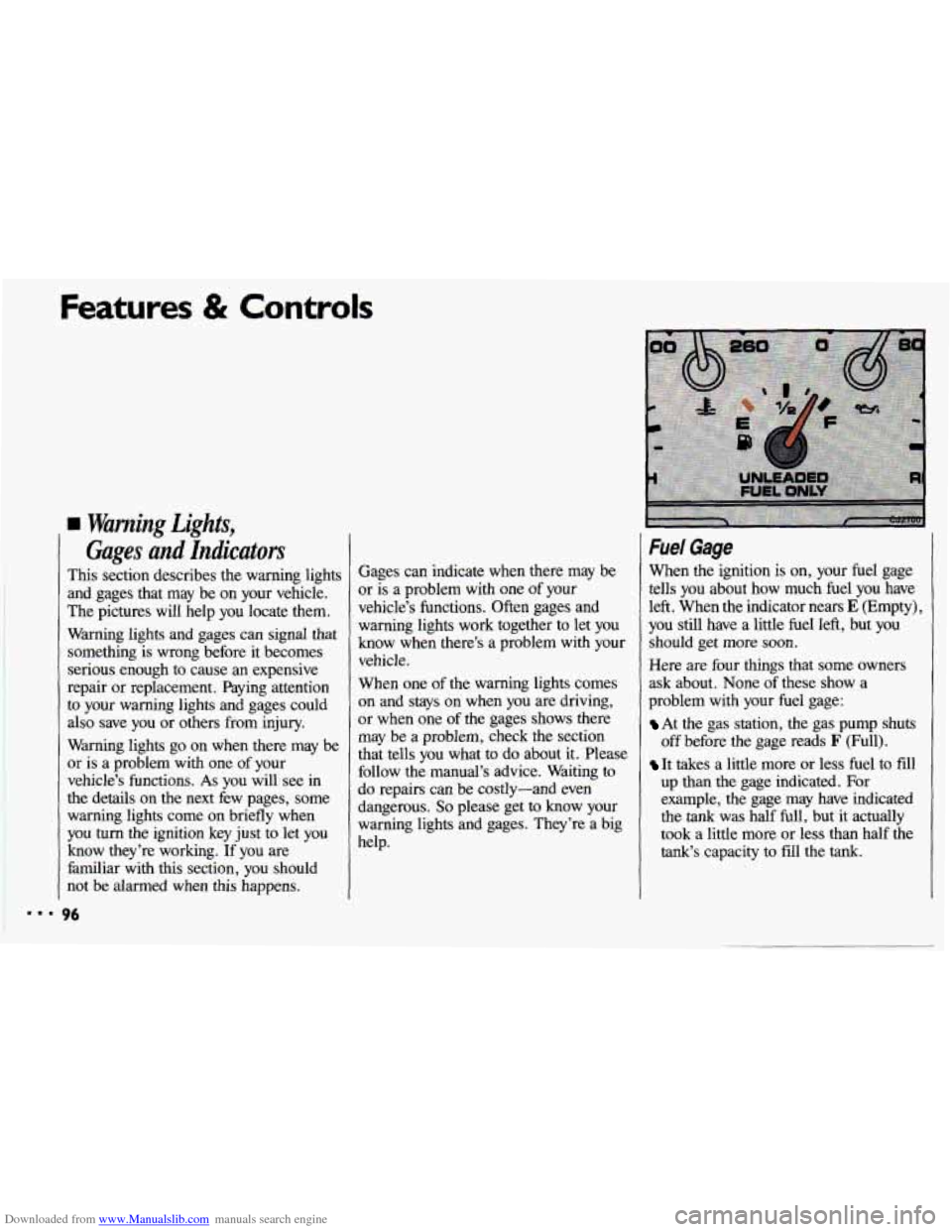
Downloaded from www.Manualslib.com manuals search engine Features & Controls
Warning Lights,
Gages and Indicators
This section describes the warning lights
and gages that may be on your vehicle.
The pictures will help
you locate them.
Warning lights and gages can signal that something is wrong before it becomes
serious enough
to cause an expensive
repair or replacement. Paying attention
to your warning lights and gages could also save you or others from injury.
Warning lights
go on when there may be
or is a problem
with one of your
vehicle’s functions.
As you will see in
the details on the next few pages, some
warning lights come on briefly when
you turn the ignition key just to let you
know they’re working. If you are
familiar with this section, you should
not be alarmed when this happens. Gages can indicate when there
may be
or is a problem with one
of your
vehicle’s functions. Often gages
and
warning lights work together to let you
know when there’s a problem with your
vehicle.
When one of the warning lights comes
on and stays on when you are driving,
or when one
of the gages shows there
may be a problem, check the section
that tells you what to do about it. Please
follow the manual’s advice. Waiting to
do repairs can be costly-and even
dangerous.
So please get to know your
warning lights and gages. They’re a big
help.
Fuel Gage
When the ignition is on, your fuel gage
tells
you about how much fuel you have
left. When the indicator nears
E (Empty),
you still have a little fuel left, but you
should get more soon.
Here are four things that some owners
ask about. None
of these show a
problem with your fuel gage:
At the gas station, the gas pump shuts
off before the gage reads
F (Full).
It takes a little more or less fuel to fdl
up than the gage indicated. For
example, the gage may have indicated
the
tank was half full, but it actually
took a little more or less than half the
tank‘s capacity to fill the tank.
Page 103 of 308
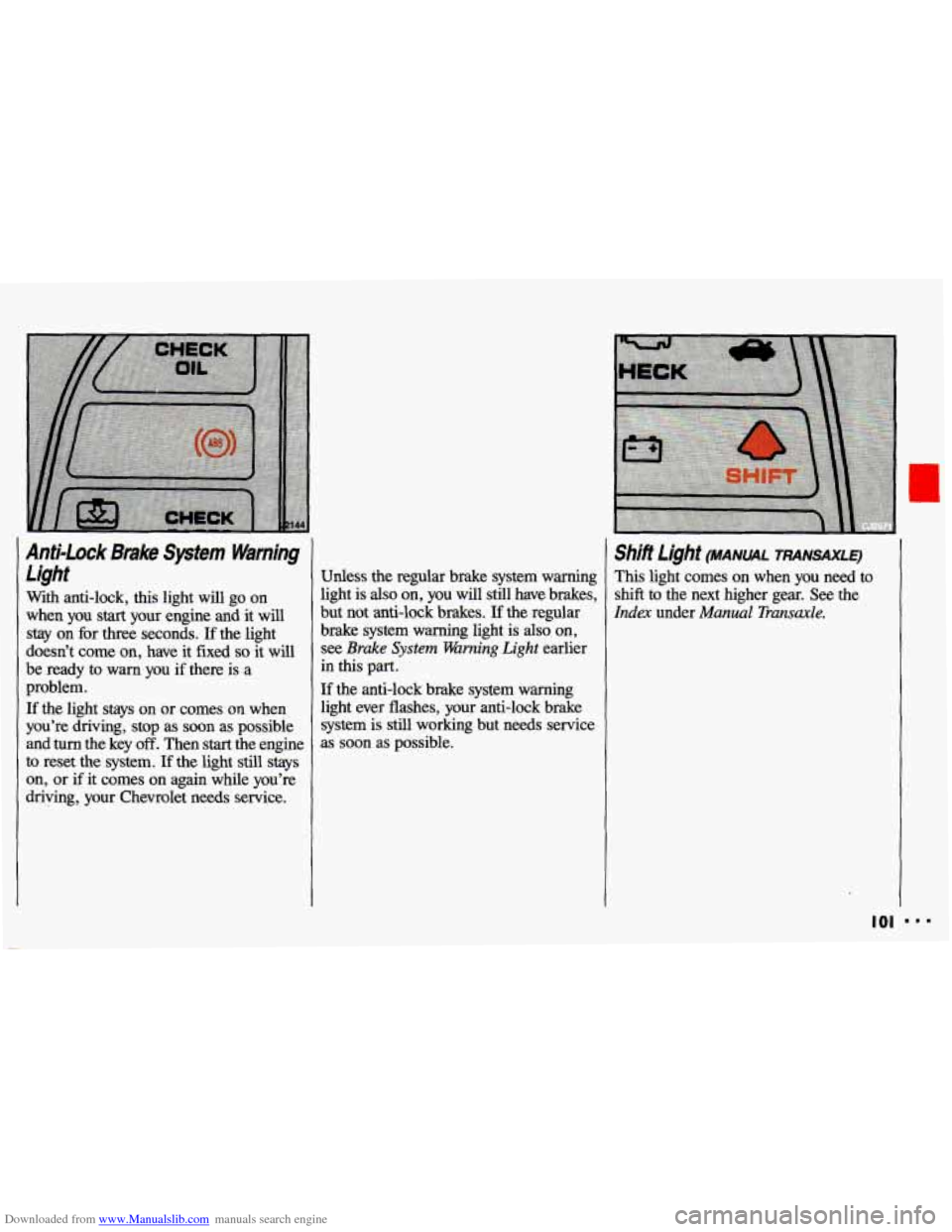
Downloaded from www.Manualslib.com manuals search engine Anti-Lock Brake System Warning
Light
With anti-lock, this light will go on
when you
start your engine and it will
stay on for three seconds.
If the light
doesn’t come on, have it fixed
so it will
be ready to warn you if there is a
problem.
If the light stays on or comes on when
you’re driving, stop as soon as possible
and turn the key
off. Then start the engine
to reset the system.
If the light still stays
on, or if it comes on again while you’re
driving, your Chevrolet
needs service.
Shift light (MANUAL TRANSAXLE)
Unless the regular brake system warning
brake system warning light is
also on,
Index under Manual Transale. but not anti-lock brakes. If the regular shift to the next higher gear. See
the
light is
also on, you will still have brakes, This
light comes on when you need to
in this part.
see Brake System Warning Light earlier
If the anti-lock brake system warning
light ever flashes, your anti-lock brake
system is still working but needs service
as soon as possible.
IO1
Page 131 of 308
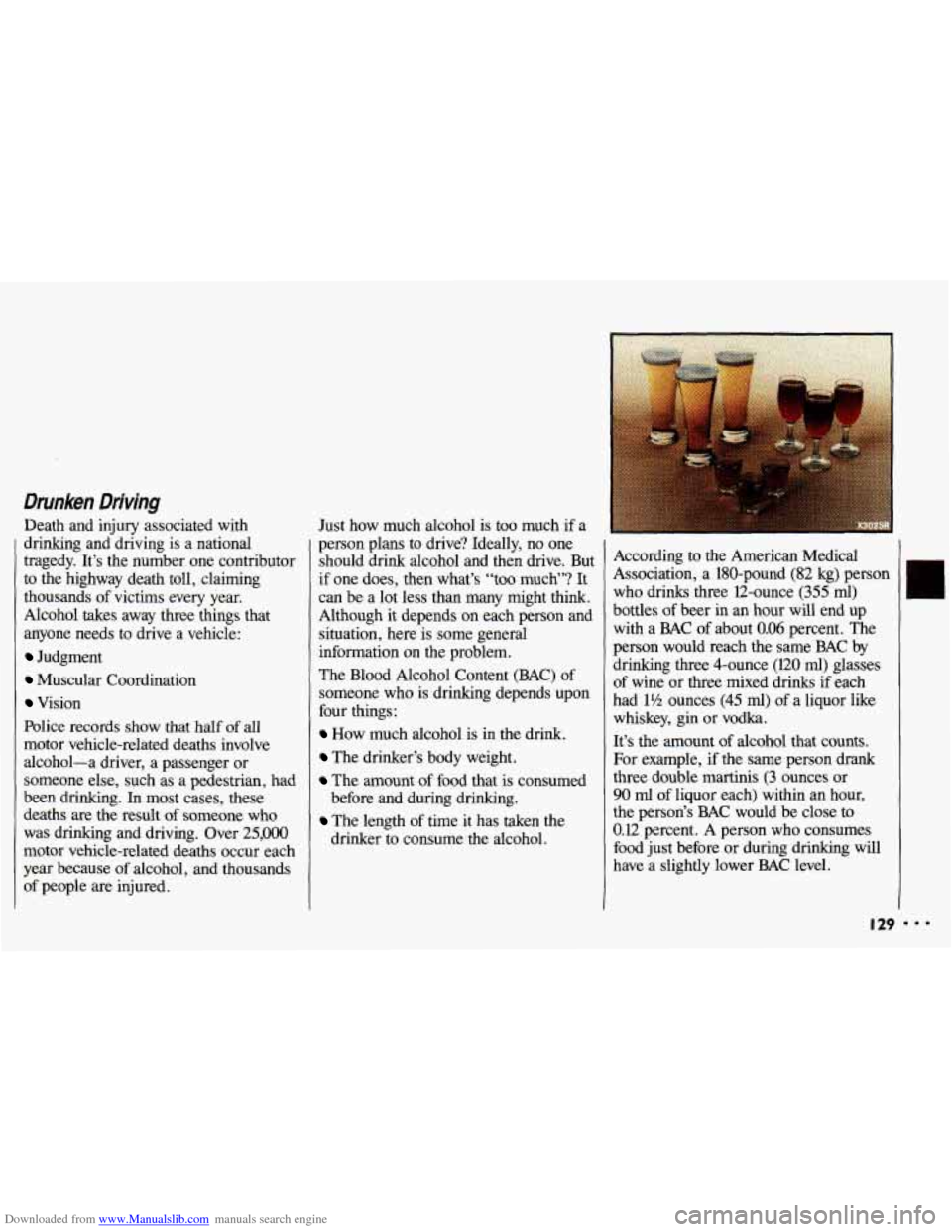
Downloaded from www.Manualslib.com manuals search engine Drunken Driving
Death and injury associated with
drinking and driving
is a national
tragedy. It’s the number one contributor
to the highway death toll, claiming
thousands of victims every year.
Alcohol takes
away three things that
anyone needs to drive a vehicle:
Judgment
Muscular Coordination
Vision
Police records
show that half of all
motor vehicle-related deaths involve alcohol-a driver, a passenger or
someone else, such as
a pedestrian, had
been drinking. In most cases, these
deaths are
the result of someone who
was drinking and driving. Over 25,000
motor vehicle-related deaths occur each
year because
of alcohol, and thousands
of people are injured. Just
how much alcohol
is too much if a
person plans to drive? Ideally, no one
should
drink alcohol and then drive. But
if one does, then what’s “too much”? It
can be a lot
less than many might think.
Although it depends on each person and
situation, here is
some general
information
on the problem,
The Blood Alcohol Content
(BAC) of
someone who is drinking depends upon
four
things:
How much alcohol is in the drink.
The drinker’s body weight.
The amount of food that is consumed
before and during
drinking.
The length of time it has taken the
drinker to consume the alcohol. According to
the American Medical
Association,
a 180-pound (82 kg) person
who drinks three E-ounce
(355 ml)
bottles of beer in an hour will end up
with a BAC of about 0.06 percent. The
person would reach the same BAC by
drinking three 4-ounce (120 ml) glasses
of wine or three mixed drinks if each
had
1% ounces (45 ml) of a liquor like
whiskey, gin or vodka.
It’s the amount of alcohol that counts,
For example, if the same person drank
three double martinis (3 ounces or
90 ml of liquor each) within an hour,
the person’s
BAC would be close to
0.12 percent. A person who consumes
food just before or during drinking will
have
a slightly lower BAC level.
I29 I..
Page 166 of 308
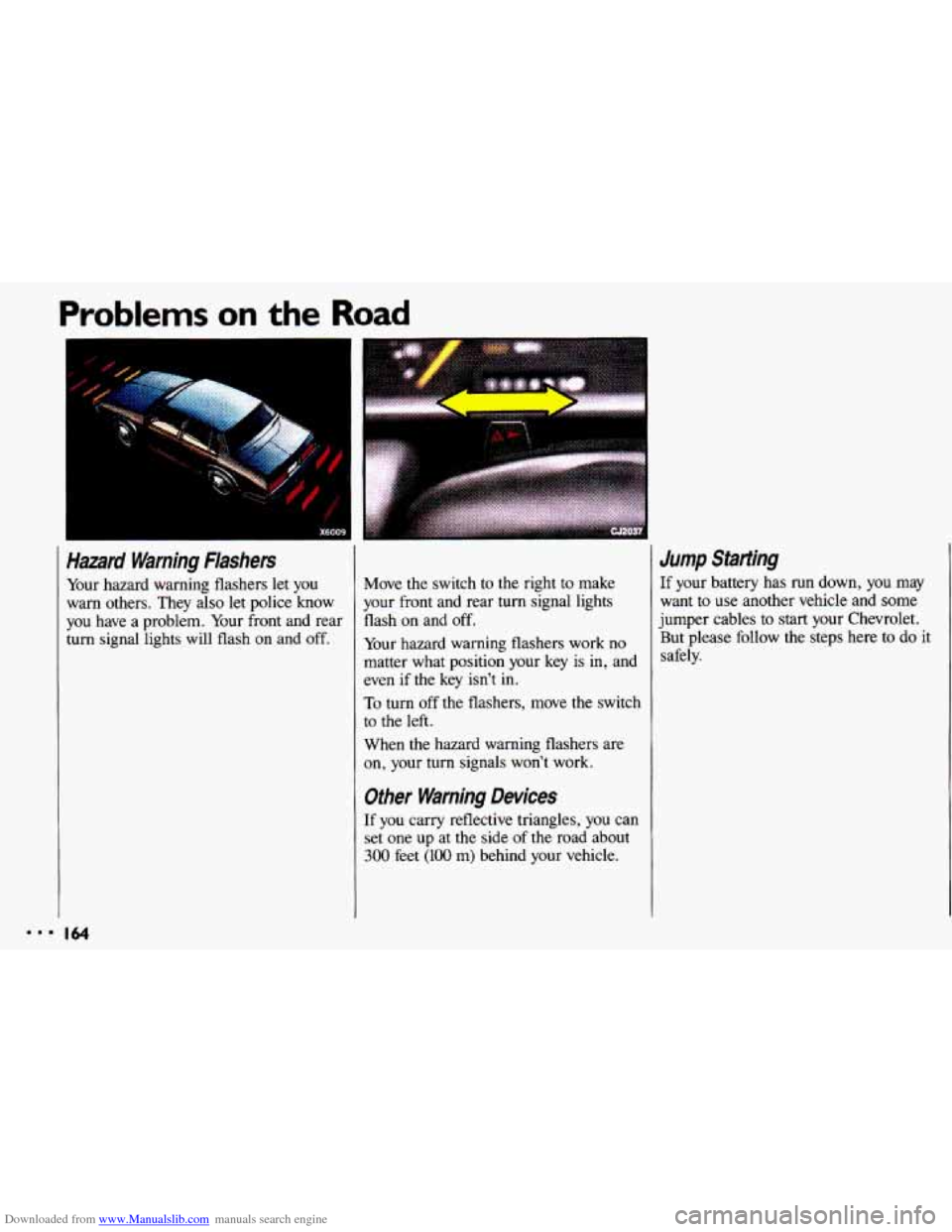
Downloaded from www.Manualslib.com manuals search engine Problems on the Road
-<.'
I X600!
Hazard Warning Flashers
Your hazard warning flashers let you
warn others. They also let police know
you have a problem. Your front and rear
turn signal lights will flash on and off. Move
the switch to the right to make
your front and rear turn signal lights
flash on and off.
Your hazard warning flashers
work no
matter what position your key
is in, and
even if the key isn't in.
To turn off the flashers, move the switch
to the left.
When the hazard warning flashers are
on, your turn signals won't work.
Other Warning Devices
If you carry reflective triangles, you can
set one up at the side of the road about
300 feet (100 m) behind your vehicle.
Jump Starling
If your battery has run down, you may
want to use another vehicle and some
jumper cables
to start your Chevrolet.
But please follow the steps here to do it
safely.
Page 172 of 308
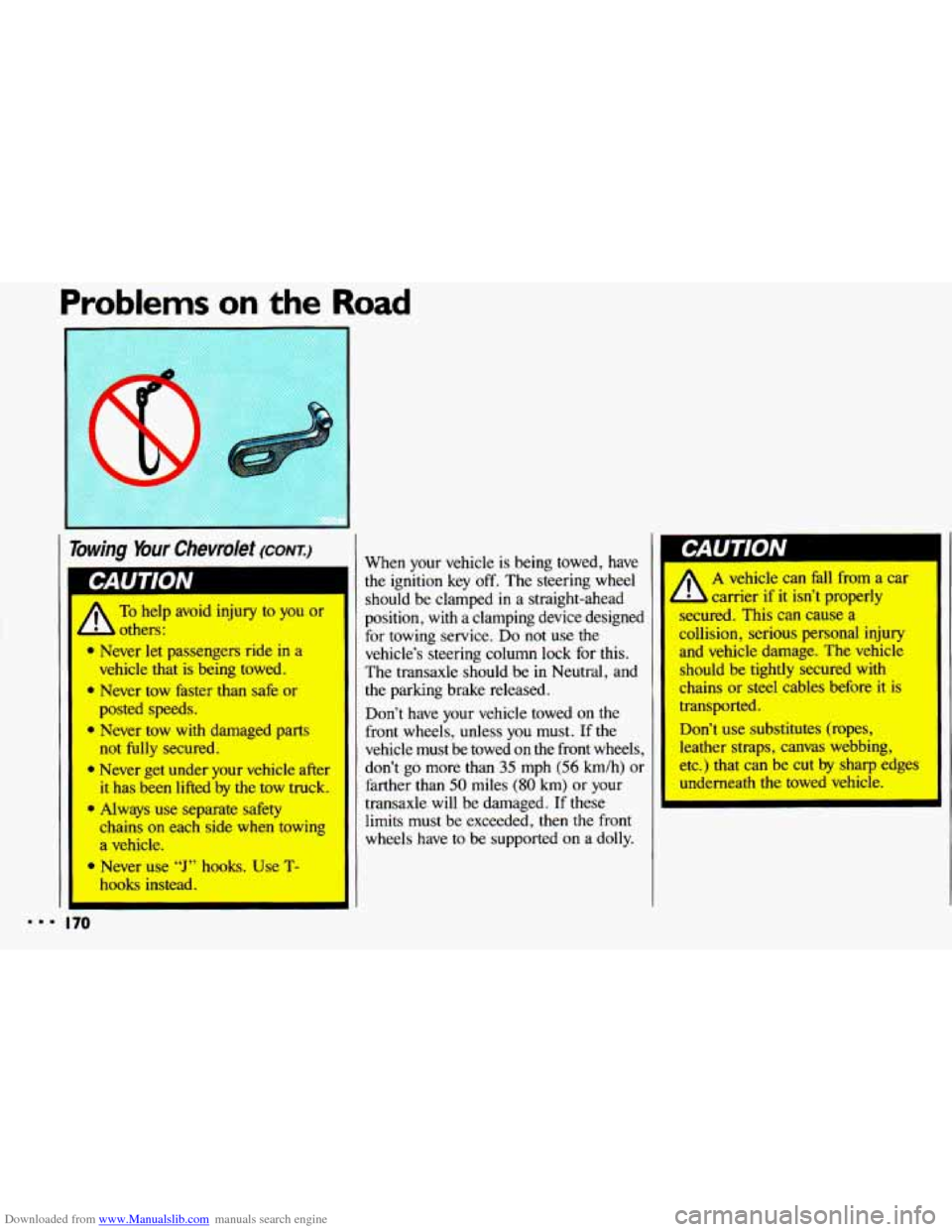
Downloaded from www.Manualslib.com manuals search engine Problems on the Road
bwing Your Chevrolet (CONI)
To help avoid injury to you or
lers:
a Never let passengers ride in a
vehicle that is being towed.
a Never tow faster than safe or
posted speeds.
* Never tow with damaged parts
not fully secured.
* Never get under your vehicle after
it
has been lifted by the tow truck.
* Always use separate safety
chains on each side when towing
a vehicle.
Never use
“J” hooks. Use T-
hooks instead.
the ignition key off. The steering wheel
should be clamped
in a straight-ahead
position,
with a clamping device designed
for towing service. Do not use the
vehicle’s steering column lock for this.
The transaxle should be
in Neutral, and
the parking brake released.
Don’t have your vehicle towed on the
front wheels, unless
you must. If the
vehicle must be towed on the front wheels,
don’t go more than
35 mph (56 km/h) or
farther than
50 miles (80 km) or your
transaxle will be damaged. If these
limits must be exceeded, then
the front
wheels have to be supported on a dolly.
p-AU I IUN I
A vehicle can fall from a car
carrier if it isn’t properly
secured. This can cause a
collision, serious personal injury
and vehicle damage. The vehicle
should be tightly secured with
chains or steel cables before it is
transported.
Don’t use substitutes (ropes,
leather straps, canvas webbing,
etc.) that can be cut
by sharp edges
underneath
the towed vehicle.
A
mmm 170
Page 274 of 308
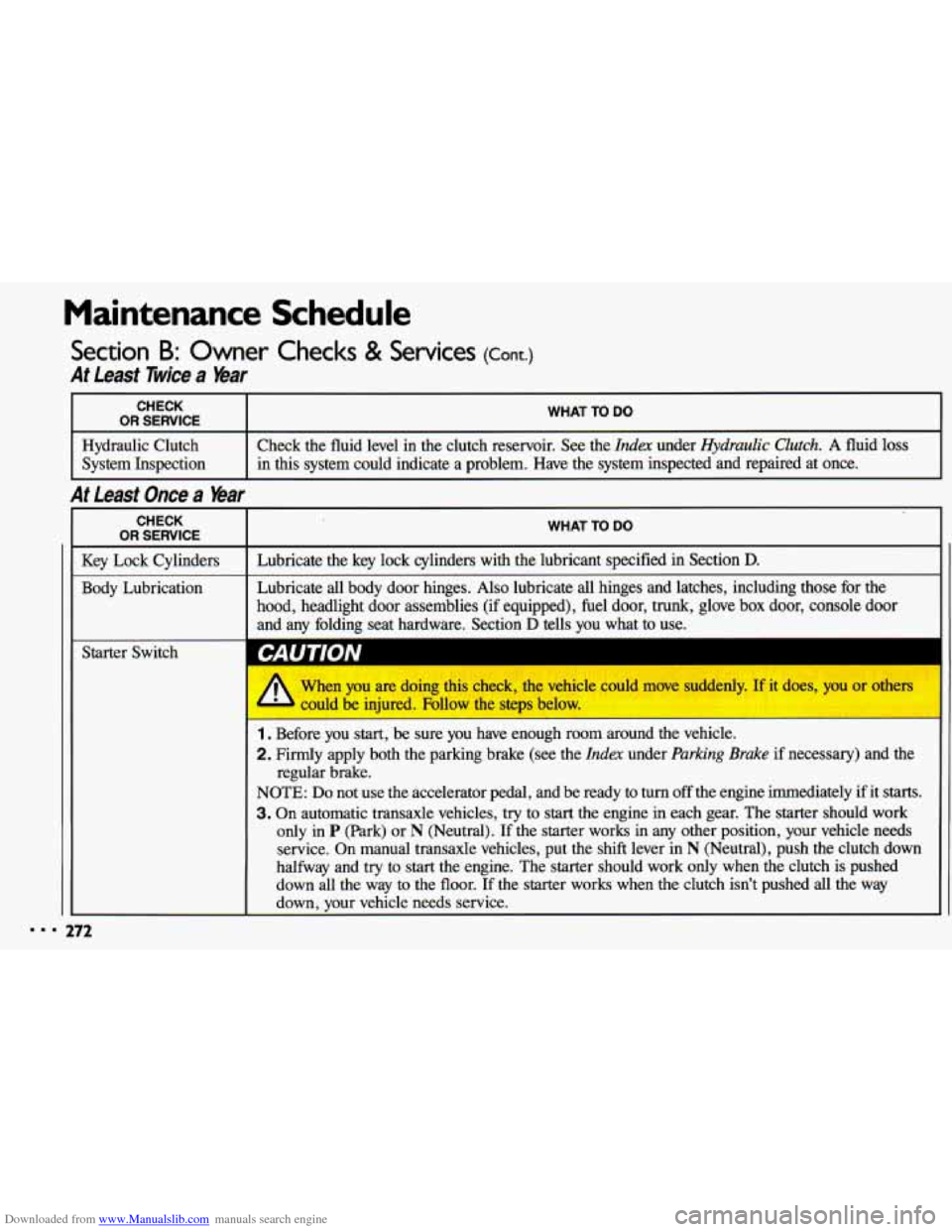
Downloaded from www.Manualslib.com manuals search engine Maintenance Schedule
Section B: Owner Checks & Services (Cont.)
At Least Twice a Year
... L
CHECK
I OR SERVICE I WHAT TO DO
Hydraulic Clutch
in this system could indicate a problem. Have the system inspected and repaired at once. System Inspection
Check
the fluid level in the clutch reservoir. See the Index under Hydraulic Clutch. A fluid loss
At Least Once a Year
CHECK
I OR SERVICE I WHAT TO DO
I
Key Lock Cylinders I Lubricate the key lock cylinders with the lubricant specified in Section D.
Body Lubrication Lubricate all body
door hinges. Also lubricate all hinges and latches, including those \
for the
hood, headlight door assemblies (if equipped), fuel door, trunk, glove box door, console door
and any folding seat hardware. Section
D tells you what to use.
L
272
I CAUTION
1. Before you start, be sure you have enough room around the vehicle.
2. Firmly apply both the parking brake (see the Index under Parking Brake if necessary) and the
NOTE:
Do not use the accelerator pedal, and be ready to turn off the engine immediately if it starts.
3. On automatic transaxle vehicles, try to start the engine in each gear. The starter should work
only in P (Park) or N (Neutral). If the starter works in any other position, your vehicle needs
service. On manual transaxle vehicles, put the shift lever in
N (Neutral), push the clutch down
halfway and
try to start the engine. The starter should work only when the clutch is pushed
down all the way to the floor. If the starter works when the clutch isn’t pushed all the way
down, your vehicle needs service.
regular brake.
I
Page 275 of 308

Downloaded from www.Manualslib.com manuals search engine CHECK
OR SERVICE WHAT TO DO
Interlock-BTSI (Automatic Transaxle
Steering Column Lock When
you are doing this check, the vehicle could move suddenly. If
it does, you or others
could be injured. Follow the steps below.
I
1. Before you start, be sure you have enough room around the vehicle. It should be parked on h
2. Firmly apply the parking brake (see the Ida under Parking Brake if necessary).
NOTE: Be ready to apply the regular brake immediately if the vehicle begins to move.
level surface.
3. With
the engine off, turn the key to the RUN position, but don’t start the engine. Without
applying the regular brake, try to move the shift lever
out of P (Park) with normal effort. If
the shift lever moves
out of P (Park), your vehicle’s BTSI needs service.
While parked, and with the parking brake set, try to turn the key
to Luck in each shift lever
position.
With an automatic transaxle, the key should turn to Lock only when the shift lever is in
P (Park).
With a manual transaxle, the key should turn to Lock only when the shift lever is in
R (Reverse).
On vehicles with a key release lever, try to turn the key to Lock without pressing the lever. The
key should
turn to Lock only with the key lever depressed. On all vehicles, the key should come
out only in
Lock.
273
Page 279 of 308
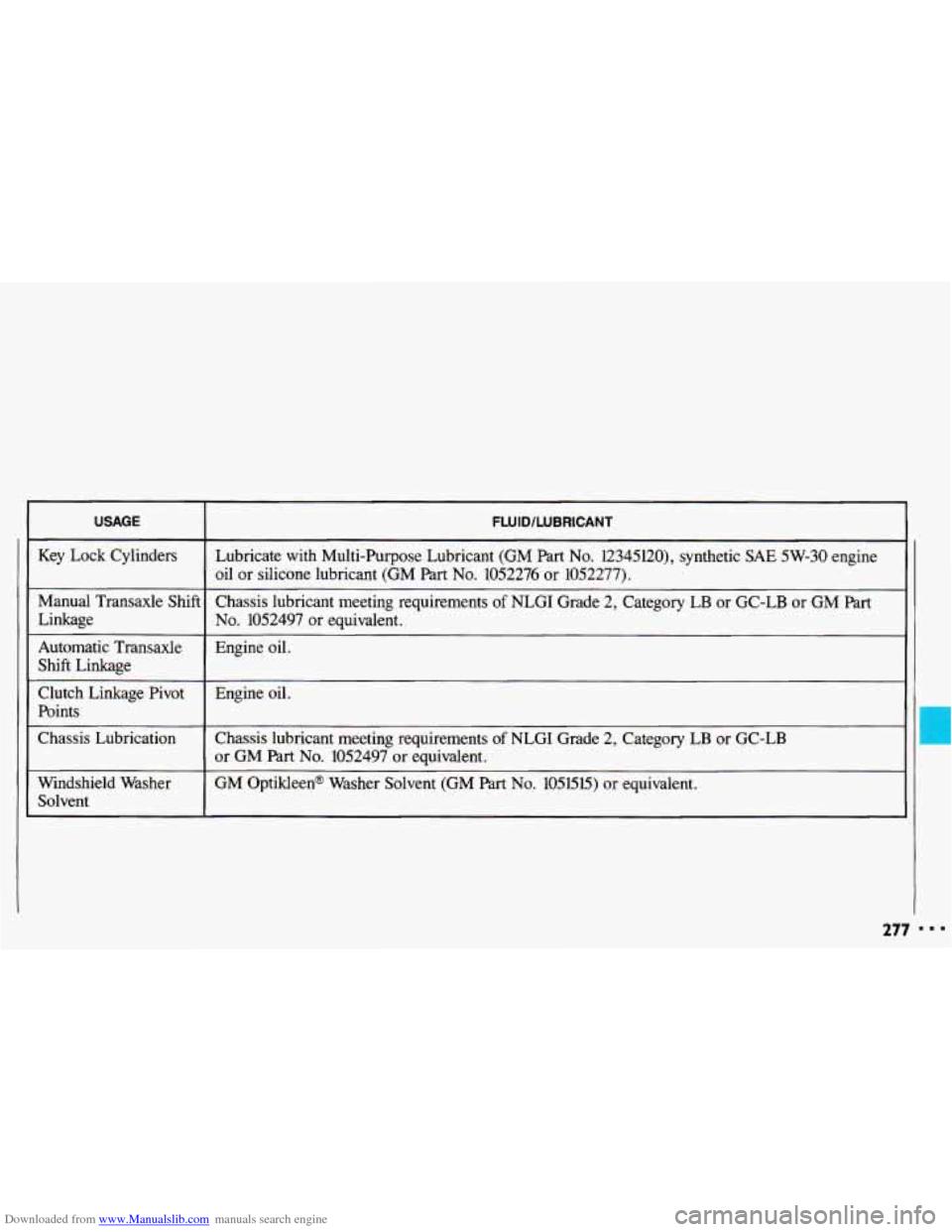
Downloaded from www.Manualslib.com manuals search engine I USAGE FUIID/LUBRICANT
Key Lock Cylinders Lubricate with Multi-Purpose Lubricant (GM Part No. l2345l20), synthetic SAE SW-30 engine
oil or silicone lubricant (GM
Part No. 1052276 or 1052277).
Manual Transaxle Shift Chassis lubricant meeting requirements of NLGI Grade 2, Category LB or GC-LB or GM Part
Linkage No. 1052497 or equivalent.
Automatic Transaxle Engine oil.
Shift Linkage
Clutch Linkage Pivot Engine oil.
Points
Chassis Lubrication Chassis lubricant meeting requirements
of NLGI Grade 2, Category LB or GC-LB
Windshield Washer GM Optikleen@ Washer Solvent (GM
Part No. 1051515) or equivalent.
Solvent or
GM
Part No. 1052497 or equivalent.
277